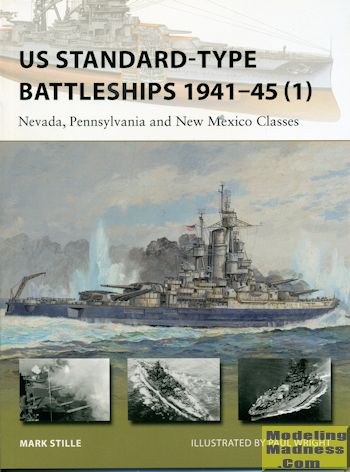 After
the HMS Dreadnought was launched, battle ship design took quite a turn and
nations developed ships that were mainly big gun ships with secondary armament
for in close combat. The US lagged a bit behind the British and Germans, but did
start producing dreadnaught class ships. Some of these ships lasted through the
20s and 30s to go to war during WWII.
After
the HMS Dreadnought was launched, battle ship design took quite a turn and
nations developed ships that were mainly big gun ships with secondary armament
for in close combat. The US lagged a bit behind the British and Germans, but did
start producing dreadnaught class ships. Some of these ships lasted through the
20s and 30s to go to war during WWII.
These ships were of three major classes, the Nevada, Pennsylvania and
New Mexico classes. Though multiple ships were originally envisioned, the
reality of funding and the improvements in ship design meant that only two or
three of each class were actually commissioned. The end of WWI saw a major
slow-down and the Washington Conference of 1921 meant that many were broken up
before being built in order to meet treaty tonnage limitations.
US battleship philosophy was somewhat different from those of other
nations. For one thing, after the two ships of the Nevada class were built, to
increase fire power, it was decided to put three guns in all the turrets. The
Nevada class had just two guns in the superfiring turrets for a total of 10. So now the ships would have access to 12 naval rifles
without the need for additional turrets. All were armed with 14 inch guns, which was considered more than
adequate for the time. US battleships also had greater amounts of armor,
especially on the horizontal surfaces. This meant a heavier, slower ship, but
was considered to be an acceptable trade off. US ships also only armored those
areas that were critical to the survival of the ship. This meant that the bows
and sterns were virtually without armor, as were most of the superstructure.
Though the treaty limited ship building and tonnage, it did not affect
upgrades and these ships were upgraded considerably during their lifespan. Since
most of them received considerable damage at Pearl Harbor, what came out of the
drydocks after repairs was a nearly unrecognizable ship from the one that was
before. While these ships did not really see any ship to ship combat, they were
indispensable as floating artillery and were used in the various major
amphibious operations in both the Atlantic and Pacific theaters of operation.
Once the war was over, these ships were quickly broken up or used in various
tests or as targets. Only one was ever fully sunk and that was the Pennsylvania class
USS Arizona.
Author Mark Stille covers the full development of each of these ship
classes, including the design and differences between the classes. Each
modification and overhaul is covered as well as their combat history during
WWII. There is also quite a bit of coverage of the various ship treaties between
the wars, as these affected ship development quite a bit. If you add in the
great period photos and the art work/illustrations of Paul Wright, it adds up to
a most desirable book and one that you will want on your shelves.
March 2015
For more on the complete line of Osprey books,
visit http://ospreygrp.com. In the US, it is
Osprey Direct at 44-02 23rd St, Suite 219, Long Island City, NY 11101., where you can
get a catalogue of available books.
If you would like your product reviewed fairly and
fairly quickly, please
contact
the editor or see other details in the
Note to
Contributors.
 After
the HMS Dreadnought was launched, battle ship design took quite a turn and
nations developed ships that were mainly big gun ships with secondary armament
for in close combat. The US lagged a bit behind the British and Germans, but did
start producing dreadnaught class ships. Some of these ships lasted through the
20s and 30s to go to war during WWII.
After
the HMS Dreadnought was launched, battle ship design took quite a turn and
nations developed ships that were mainly big gun ships with secondary armament
for in close combat. The US lagged a bit behind the British and Germans, but did
start producing dreadnaught class ships. Some of these ships lasted through the
20s and 30s to go to war during WWII.